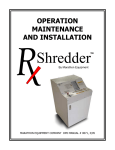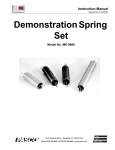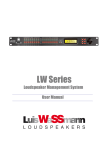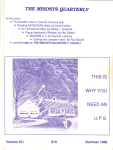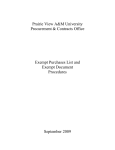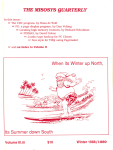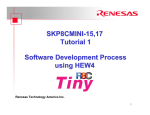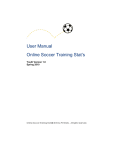Download Physics Of Hovercrafts 2
Transcript
Visualizing Vectors on the Force Table Royal High School Physics, Fall 2007 Purpose and Introduction The following exercise, adapted from one of the PVAMU Physics laboratory exercises, is meant to serve as a primer for vectors from an experimental perspective. Students may want to perform this experiment before performing any of the hovercraft experiments. This activity meets State of Texas TEKS requirements from §112.42, IPC (c)(4)(A),(B); §112.47, Physics, including items (c)(4)(C) to (E) and (5)(B) to (D). http://www.tea.state.tx.us/teks/. More details about these and other national science education teaching standards can be found at websites such as http://www.nsta.org/ A vector is a mathematical object used to represent quantities, which have two (or more) independent dimensions, such as magnitude and direction. We are going to visualize vectors using two methods, experimental and graphical. The purpose of this exercise is to familiarize the student with how vectors work and how they add together. To investigate the nature of vector addition experimentally we will use a force table to add two vectors by measuring the net effect of the forces when the system is at equilibrium. Experimental steps: Procedure 1. Case 1 ♦ Put 150 grams on A and B (two vectors) and position them at 45 and 135 degrees. ♦ Add masses to the negative of the resultant, R (the vector that results when you add the first two together) and vary the angle of the resultant until the circle is balanced in the middle of the force table. ♦ Don’t forget to include the mass of the weight hanger (50g). When this occurs a state of equilibrium exists and the sum of the vectors should be zero. ♦ Add these same two vectors graphically (scale their lengths so that 150g = 1.5cm on the graph, use a separate sheet of graph paper for this), measure the angle and length of the resultant and compare that to the force table resultant. 2. Calculate the force on each vector in SI units for Case 1. You will need to convert measured values in grams to kg, and then remember that A is a force vector and so must be in Newtons (A = mg). Values should be stated using 3 significant figures. D the same for B and R and write your results in the space below. 3. Draw a picture of the force table top with all vectors used in part 1 labeled correctly. 4. Work the following cases, following the bulleted list of exercises for Case 1. Be sure to convert all masses to Newtons (as described in #2) for the final answers. ♦ Case 2: A = 100 grams at 45 degrees; B = 100 grams at 110 degrees A = _______N B = _______N R = _______N at _______degrees ♦ Case 3: A = 150 grams at 15 degrees; B = 200 grams at 60 degrees A = _______N B = _______N R = _______N at _______degrees ♦ Case 4: A = 50 grams at 0 degrees; B = 150 grams at 90 degrees A = _______N B = _______N R = _______N at _______degrees ♦ Case 5: A = 50 grams at 0 degrees; B = 150 grams at 75 degrees; C = 100 grams at 90 degrees A = _______N B = _______N R = _______N at _______degrees C = _______N Visualizing Motion with PASCO’s Motion Sensor Royal High School Physics, Fall 2007 Purpose The purpose of this activity is to visualize motion with the PASCO motion sensor and to use the sensor to match graphs of position versus time using the student as the object in motion. An important skill to have is to be able to look at a graph and to tell what it is communicating. An excellent way to get practice with this is to make your own graphs. Graphs are an excellent way to tell a lot of information without using a lot of words. We will look at some graphs of position versus time. If the position stays the same, we see a horizontal line on the graph. If the position changes, the line is tilted or curved, depending on how it changes over time. The change in position over time is referred to as “velocity” or “motion”. We will ultimately investigate position, velocity, and acceleration and see how they are related to each other. However, we will stick to position for this exercise. This activity meets State of Texas TEKS requirements from §112.42, IPC (c)(4)(A),(C); §112.47, Physics, including items (c)(4)(A), (C), and (E). http://www.tea.state.tx.us/teks/. More details about these and other national science education teaching standards can be found at websites such as http://www.nsta.org/ Equipment The following will be needed to perform the experiment successfully. ♦ PASCO X-plorer GLX handheld data logger ♦ Digital adaptor for the datalogger ♦ Meter stick ♦ PASCO motion sensor ♦ Several sheets of graph paper ♦ Stopwatch or timer Procedure The Motion Sensor works by putting out pulses of sound and converting the travel times to distance. It works with the knowledge of the speed of sound in air (331.4 m/sec.) and the fact that the round-trip travel time multiplied by this speed value divided by two gives the distance to an object. The object reflects the sound pulses back to the Motion Sensor which makes it possible to calculate the distance to the object. The device makes 10 measurements per second and usually plots these values on a distance versus time graph. The software that works with the motion sensor can also calculate velocity by taking the differences between each consecutive reading of position and converting that to a velocity value. It can also display acceleration by taking the differences between consecutive velocity values. You will be studying the relationship between position, velocity and acceleration in class, but we will start with position in this exercise. It may be helpful to play around with the motion sensor for a few minutes before starting this exercise. That way, you can get a feel for how it works and how changing your position changes the appearance of the graph (of distance versus time) as it is being plotted. Also, study the graphs, which both span 30 seconds, and plan how to move in order to match these graphs Match graph #1 with your own motion, holding the motion sensor so that it points toward a wall (which will serve as the “object” which will reflect the sound waves, thus gauging your distance from the wall). It may be helpful to have someone time you with a stopwatch, calling out the time every five seconds (e.g. “5…10…15…20…”) so that you can maintain your pace with the graph. Compare your results with the actual plot below. Visualizing Position-Run #1 12.0 Distance (m.) 10.0 8.0 6.0 4.0 2.0 0.0 1 3 5 7 9 11 13 15 17 19 21 23 25 27 29 Time (sec.) Repeat the procedure, now using Run #2 (below). Notice that this one is a bit more complicated and will necessitate quick moves on your part. Visualizing Position-Run #2 12.0 10.0 Distance (m) 8.0 6.0 4.0 2.0 0.0 1 3 5 7 9 11 13 15 17 19 21 23 25 27 29 Time (sec.) Finally, make similar graphs for each other to follow, using pencil and ruler and graph paper. Be challenging enough to make it interesting but be realistic as well (the motion sensor has a range of 11.0 meters, and people can run only so fast…). When you are finished with all this activity, answer the following questions (your teacher may have additional questions to go with these). Results and Conclusions 1. Comment on how difficult, or easy, it was to match the graphs that were provided with this exercise and also by your classmates. 2. What was happening when the line was horizontal? Why? 3. What was happening when the line was tilted and how does the steepness of the tilt relate to what happened? 4. How do these graphs show the relationship between position and velocity? 5. Is the Motion Sensor accurate? Place the sensor (preferably mounted on a support rod / stand for steadiness) exactly 2.0 meters from the wall and activate. Set the readout to “Digits” mode and take a few random numbers from the readings (up to 5 numbers) and take the average of these. Does the average equal 2.0? If not, why not? How far off was the Motion Sensor (if it read an incorrect distance)? Hovercrafts and Newton’s 3 Laws of Motion Royal High School Physics, Fall 2007 Purpose The purpose of this activity is to investigate Newton’s 3 Laws of Motion using a PASCO force platform, motion sensor and hovercraft. Introduction to the Activity The hovercraft provides many fun opportunities to do demonstrations and experiments involving brave student volunteers studying the concepts of momentum, collisions, velocity, vectors, and forces. There are many real-world applications to the hovercraft, as analogs of the laboratory model are used in daily life. Some everyday examples include air-cushioned vehicles (or ACV’s) which travel atop a layer of compressed air and can travel over land or water. These carry people, vehicles or freight, and can move at speeds up to 80 mph. The large PASCO hovercraft provides an excellent opportunity to investigate Newton’s three laws of motion experimentally. The following exercise was adapted from the experiment and user’s manual that came with the hovercraft. We have reproduced it and changed it slightly for this exercise. Some of the activity involves drawing vectors (you should complete the “Visualizing Vectors” exercise before starting this one…) and the use of the force platform (you should complete at least the first part of the “Forces, Motions, and Hovercrafts” exercise prior to starting this one…). This activity meets State of Texas TEKS requirements from §112.42, IPC (c)(4)(A),(B); §112.47, Physics, including items (c)(4)(C) to (E) and (5)(B) to (D). http://www.tea.state.tx.us/teks/. More details about these and other national science education teaching standards can be found at websites such as http://www.nsta.org/ Equipment The equipment needed for this activity is as follows: ♦ 1 PASCO Hovercraft with air supply ♦ 1 Meter stick ♦ Masking Tape ♦ Stopwatch ♦ 2 PASCO Xplorer GLX hand-held data loggers, fully charged ♦ 2 Digital adaptors for the GLX ♦ 1 PASCO motion sensor ♦ 2 PASCO Force Platforms Procedure In this experiment, we will investigate Newton’s three laws of motion. The activity is adapted from PASCO’s Experiment and User Guide for the Hovercraft. These can also be useful in exploring position, velocity and acceleration. Newton’s First Law • Several students will observe the motion, one will be the “catcher” to stop the Hovercraft, and another will be the “marker” to mark the motion of the craft with tape placed on the floor • Set up the motion sensor, connected to an Xplorer GLX, so it will be able to measure the distance and velocity of the person on the hovercraft. Press the Play button when you are ready to put the rider in motion. • Provide a brief push to the rider, then start the stopwatch • The marker will then mark the position of the hovercraft each second, as well as at the start and end of a 5-second interval • After the last mark is placed, stop the Hovercraft • Answer the questions in the final section. Newton’s Second Law • Assign the same roles from Experiment 1 to different students, and give another student a chance to be the rider • Place the motion sensor behind the rider, so as not to run over it when you pull the rider. Press the Play button when you are ready to start. • Using a rope, provide a constant force to the rider for about 3 seconds. • Have the “marker” mark the position of the Hovercraft each second • After moving across the floor for 5 seconds, stop the vehicle, then stop the Motion Sensor • Answer the questions in the final section Newton’s Third Law • Assign the same roles from Experiment 1 to different students, and give another student a chance to be the rider (except that no markers will be needed in this case) • The “pusher” should hold the Force Platform perpendicular to the ground • The “rider” should place the second Force Platform up against the pusher’s. • The pusher should provide a force to the rider for about 1 second • After moving across the floor for about 5 seconds, stop the vehicle • Answer the questions in the final section. Questions-Newton’s First Law of Motion 1. Describe the motion both during and after the push 2. Draw a force diagram for the rider both during and after the push 3. Describe the position versus time and velocity versus time graphs (you can print them out as well…). Based on the appearance of the velocity graph, is the rider traveling at a constant velocity? 4. Describe the spacing between the marks on the floor, and what is suggested about the motion of the Hovercraft? Make a plot of the distance versus time based on stopwatch and mark data. How does this compare with that of the Motion Sensor? 5. Describe the causes of motion that you observed throughout the motion of the Hovercraft Questions-Newton’s Second Law of Motion 1. Describe the motion both during and after the pull 2. Draw a force diagram for the rider both during and after the pull. 3. Describe the position versus time and velocity versus time graphs (you can print the graphs as well…). Based on the appearance of the velocity graph, is the rider traveling at a constant velocity? 4. Describe the motion of the hovercraft based on the spacing between the marks on the floor. Make a plot of the distance versus time based on stopwatch and mark data. How does this compare with that of the Motion Sensor? 5. Describe the causes of motion that you observed throughout the motion of the Hovercraft Questions-Newton’s Third Law of Motion 1. Describe the motion both during and after the push 2. Make a graph from the Force Platform data showing both the pusher’s force and the rider’s force 3. Draw force diagrams for both the pusher and rider during the push 4. Formulate a general rule about the size and direction of forces between two objects For Further Thought You probably have done one or more activities in addition to this one which were meant to illustrate one or more of Newton’s laws of motion. How are the activities similar? What is different about them? Specifically describe the common features of all the activities meant to show Newton’s Laws of motion. Forces, Motions and Hovercrafts Royal High School Physics, Fall 2007 Purpose The purpose of this activity is to investigate several interrelated physics concepts using a PASCO force platform and a PASCO hovercraft. Introduction to the Activity The hovercraft provides many fun opportunities to do demonstrations and experiments involving brave student volunteers studying the concepts of momentum, collisions, velocity, vectors, and forces. There are many real-world applications to the hovercraft, as analogs of the laboratory model are used in daily life. Some everyday examples include air-cushioned vehicles (or ACV’s) which travel atop a layer of compressed air and can travel over land or water. These carry people, vehicles or freight, and can move at speeds up to 80 mph. We will be investigating two seemingly unrelated topics in physics, but we will ultimately tie them together. This exercise is one of a series of related exercises involving the large PASCO hovercraft (the original exercise which is a combination of these is on the Internet, on the Project XLR8 Website). The first part of the exercise is actually a primer to get the student used to the PASCO force platform. The students will have the chance to see how jumps, stomps, steps, and leaps show up on a graph that shows the force exerted versus time. By measuring the peak of the graph, the student will be able to directly see the force (in Newtons) exerted on the platform during the action. Next, we will use the hovercraft to see how straight-line or translational motion compares to rotational or angular motion. We will look at these individually then put them together to get a complicated motion called a cycloid. (To see a nice animation of a cycloid, which shows a motion similar to what we will see with the Hovercraft, only faster, go to http://www.ies.co.jp/math/java/calc/cycloid/cycloid.html, go to “Applet 1” then click on “Animate”). So…how do the two relate to one another? Consider the hovercraft moving at a constant velocity across the gymnasium floor. The craft+person has a certain momentum, p, which equals the total mass multiplied by the velocity. The more mass, the greater momentum; the lower the velocity the smaller the momentum. Suppose the hovercraft were allowed to continue until it bumped into a wall, and we could measure it with the force platform. The momentum would be transferred into the wall, then back to the hovercraft in the form of an Impulse which would likely result in the craft bouncing off the wall and going another direction. This gets into a discussion of collisions which is another laboratory activity altogether. For this exercise we will focus on the two parts, and combine them later on. This activity meets State of Texas TEKS §112.47, Physics, including items http://www.tea.state.tx.us/teks/. More science education teaching standards requirements from §112.42, IPC (c)(4)(A); (c)(4)(B),(C),(E) and (5)(B) to (D). details about these and other national can be found at websites such as http://www.nsta.org/ Equipment The equipment needed for this activity is as follows: ♦ 1 PASCO Hovercraft with air supply ♦ 1 Meter stick ♦ Masking Tape ♦ Stopwatch ♦ 1 PASCO Xplorer GLX hand-held data logger, fully charged ♦ 1 PASCO Force Platform Procedure In this experiment, we will investigate forces, momentum, and motion, and how these tie together. In the first part, we get acquainted with the force platform and find out how simple actions, such as footsteps and jumps appear on a force versus time plot. We will look at these plots a bit more closely to see which ones are more pronounced. Students are encouraged to try a variety of steps, jumps, and exercises (including push-ups, standing on one foot versus two, etc.) and see how these register on the time versus force plot. We will then look more closely at the physics behind these actions. Second, we will investigate motion, both the linear (also called “translational”) and the circular (angular) forms. We will learn how they work together to produce a more complicated motion as seen from a stationary reference point. The Forces of Steps, Jumps, and Leaps We will look at the force platform by itself first (this will be used again in a separate exercise). Connect the platform to the Xplorer GLX and make sure it is displaying the graph of force versus time. Once everything is set up properly, hit “play” on the GLX and make sure a graph is plotting. Do a series of activities, one at a time, in a welldefined sequence so you can pick out one from another. It would be a good idea for a group-mate to write down the nature of each activity that affects the force platform to enable better correlation of activity to parts of the plot. The activity will include a footstep while walking, a footstep while running, standing in place on both feet then on one foot, horizontal and vertical jumps, pushups, and anything else you can think of. Make sure there are several seconds of time to give the display a chance to “flat line” so you can later tell one activity from another. Once you have all the activities, press the play button on the GLX once more to stop it and fill in the table on the following page. Activity Measured value + comments on the activity “Activity” is where you put the name of the activity, and “Measured value + comments on the activity” are where you put the times and comments. For example, you can put a value for the maximum force exerted by a single jump in place, and add the height of the jump as measured by a group-mate. You can use the “smart tool” application on the graphical portion of the GLX to find the maximum force of a given action. Having written each action down as it happens, as well as including “space” between each action to enable a distinction to be made between each action, it will be much easier to correctly identify each and correlate the correct value of force for each as measured by the GLX. To think about: How can you use some of the above activities to further your knowledge of energy, momentum, and impulse? You can include the use of the entire profile of a given action, not just the top of the peak. Rotation versus translation motion Give the Hovercraft and rider a push, but add some spin to the vehicle. Try to get the vehicle to move as straight as possible so as to not collide with the walls. Pick a point on the edge of the craft and time how long that point (you can mark it with masking tape or something that stands out) takes to make one rotation. Also mark the location of the hovercraft at the start and end of the rotation. If you were a fly on the ceiling watching what was going on below, what would the shape of the path of the masking tape marker be (the one rotating on the edge of the craft)? Draw it in the space below: Measure the diameter of the hovercraft and calculate its circumference, C = πD. Calculate the angular velocity with the formula d = vt, where d is the circumference C. How does this value compare with the value of straight-line velocity from point A to Point B?
















